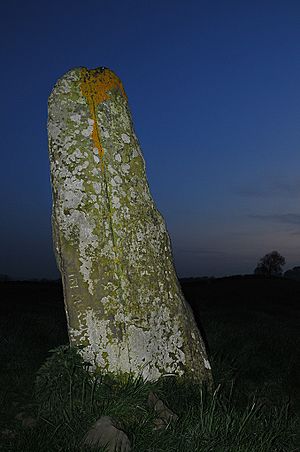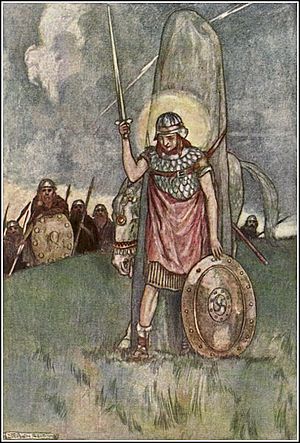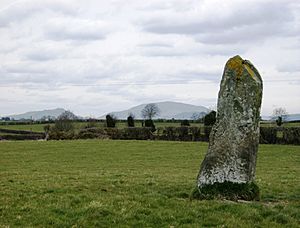Clochafarmore facts for kids
|
Cloch an Fhir Mhóir
|
|||||||||||

Clochafarmore pictured at night
|
|||||||||||
| Alternative name | Cúchulainn's Stone | ||||||||||
|---|---|---|---|---|---|---|---|---|---|---|---|
| Location | Rathiddy, Knockbridge, Dundalk, County Louth, Ireland |
||||||||||
| Coordinates | 53°58′28″N 6°27′57″W / 53.974505°N 6.465919°W | ||||||||||
| Type | Standing stone | ||||||||||
| Circumference | 4 m (13 ft) | ||||||||||
| Height | 3 m (10 ft) | ||||||||||
| History | |||||||||||
| Material | stone | ||||||||||
| Founded | c. 2000–500 | ||||||||||
| Periods | Bronze Age | ||||||||||
| Site notes | |||||||||||
| Public access | yes | ||||||||||
| Designation |
|
||||||||||
Clochafarmore is a very old standing stone in County Louth, Ireland. It is also known as "Cúchulainn's Stone" and is considered a National Monument. This means it's a special historical site protected by the country.
Contents
Where is Clochafarmore Located?
Clochafarmore is found in a field near the River Fane. It's about 1.4 kilometers (less than a mile) east of Knockbridge, a small village close to Dundalk. You can find it in a place called Rathiddy, which is in County Louth.
History and the Legend of Cúchulainn

This impressive stone stands about 3 meters (10 feet) tall. No one knows exactly when it was put there. Experts believe it was set up a very, very long time ago. This was during the Bronze Age, which was roughly between 2500 and 500 BC. That's over 2,500 years ago!
The Legend of Cúchulainn's Last Stand
Clochafarmore is famous because of a powerful Irish legend. It's said to be the place where the legendary hero Cú Chulainn met his end. Cúchulainn was a mighty warrior from ancient Irish myths.
The story goes that his enemy, Lugaid mac Con Roí, had three magical spears. A prophecy said that a king would fall with each spear.
- First, Lugaid used a spear to kill Cúchulainn's charioteer, Láeg.
- Next, he killed Cúchulainn's brave horse, Liath Macha, with another spear.
- Finally, the third spear hit Cúchulainn himself, wounding him badly.
Even though he was dying, Cúchulainn didn't give up. He tied himself to this very standing stone. This stone was already there, put up long ago to mark the grave of another great warrior. Cúchulainn wanted to die standing, facing his enemies.
The Hero's Final Moments
Cúchulainn kept fighting until a raven landed on his shoulder. In the legend, this raven was the goddess The Morrígan, showing that Cúchulainn was truly gone. Only then did his enemies believe he was dead.
Lugaid came closer and cut off Cúchulainn's head. But as he did, a bright "hero-light" shone around Cúchulainn. His sword fell from his hand, cutting off Lugaid's hand. The light only faded after Cúchulainn's right hand was also cut off.
The Field of Slaughter
The area around Clochafarmore is known as An Breisleach Mór. This means "The Great Carnage" or "The Great Slaughter." The field where the stone stands is even called the "Field of Slaughter."
In the 1920s, something interesting was found in this field: a bronze spearhead. This discovery makes people wonder if the legend is based on a real ancient battle that happened right here. It's a fascinating link between myth and history!



